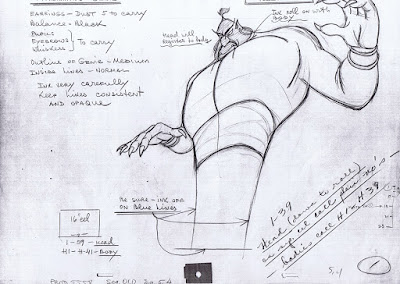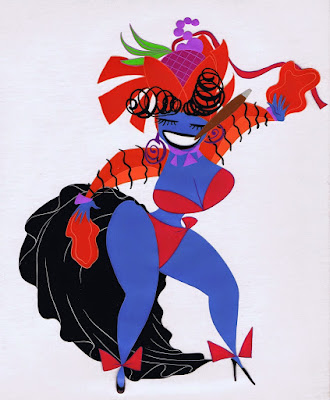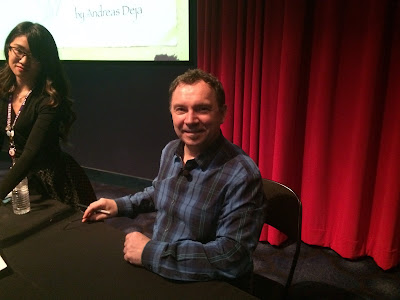"All he wanted to do is please his father Geppetto, but his lack of life experiences got him into trouble. After all, he had just been born." The sequence in the film when Pinocchio comes to life was animated by Ollie, but Fred Moore still lent a hand when appeal and drawing needed to be strengthened.
Two seconds of animated gold! This scene hasn't been pencil-tested since the movie's production. Just imagine being Walt Disney, watching the rough animation and giving comments.
I just love Ollie's work, it's so intuitive and natural. He rocks my world.
Layout and compositional study by Ollie.
Working on the title character of the film Alice in Wonderland meant a shift for Ollie Johnston from broad animated types like Susie the Little Blue Coupe to a more finessed and realistic style of animation. Live-action reference was filmed to provide a basis for the animators' work. Ollie found this method somewhat restrictive because the main acting choices were made by actress Kathryn Beaumont. But there were scenes that did call for the animator's imagination.
Ollie did scenes with mostly Trusty, the old bloodhound. Ollie sympathized with this warm, grandfatherly type, who had lost his sense of smell. Trusty's very loose skin gave the animators the opportunity to show these folds in overlapping actions, particularly in dialogue scenes. Ollie applied strong squash and stretch to Trusty's face which not only adds age, but it is simply fun to watch.
In "Sleeping Beauty" when it came time to create a wedding dress for Aurora, it was Flora who insisted on taking on this challenge. She only needed Merryweather as a model.
We all know how well that turned out. I love the dialogue between the two.
Merryweather: "It looks awful!" Flora: "That's because it's on you, dear."
The pencil test shows two scenes from "Sleeping Beauty" in continuity.
The first scene was animated by Ollie, the second by Frank.
Acting and drawing are so utterly convincing, completely alive!
Ollie stages his scene very clearly, three characters interacting, but the focus is on Flora's finger. And Frank's close up of Merryweather shows a mood change with stunning subtleties.
The way her head anticipates ever so slightly the word "frost".
This is the kind of stuff that still brings me to my knees....
This lovely sketch by Ollie Johnston shows scene continuity and staging for the introduction of Prince John and Sir Hiss in the film "Robin Hood". It is based on original storyboards, which were done by artists like Ken Anderson, Vance Gerry and Dave Michener among others.
But before Don Griffith and his layout team would start working on the the background scenery, Ollie took a last look at the story sketches, intending to improve and refine the continuity and bring out the characters' personality. He would always use his pencil very lightly, but draw fast.
Disney's next generation of animators got involved in this stage of production as a group.
They had long meetings in which storyboards were scrutinized. Present were the directors, key layout and story people and the supervising animators. Everybody was encouraged to come up with ideas that would plus what we saw in the storyboards. After all changes and improvements were made, so called "Work Books" were printed out as a final guide to the animators, layout and background artists.
If you compare Ollie's sketch to the final film, you'll find out that he pretty much stuck with what he had planned out in his "Work Book" pages.
Most of the personality scenes with the albatross Orville from the film The Rescuers were animated by Ollie Johnston. This is an interesting character, he is pilot and airplane all in one. Jim Jordan’s voice brought a confidence to the character despite his questionable flying maneuvers.
For Orville’s take offs and landings Ollie used some live action footage as reference for his animation.
The Disney 1952 documentary Water Birds included scenes of an albatross’s awkward attempts to get airborne as well as his crash landings.
Ollie Johnston animated this scene with Penny and Rufus, the old cat.
Penny is staged back view, and we don't see her face, but her body language signals resigned sadness very clearly. Rufus approaches her from screen right and tries to offer some comfort.
One character in need of affection, the other one intending to help emotionally.
In this clip of Disney Family Albums, Ollie Johnston talks about Walt Disney and The Jungle Book.
He looks scary and funny at the same time.
More of John Lounsbery (1911-1976), this work is undisputedly brilliant.
The crocodile in Peter Pan is for the most part a comedic villain, even it he ate one of Captain Hook's hands. Lounsbery animated the introductory scenes, as the croc approaches the ship in hopes to get the rest of Hook.
Here is the tied down pencil test of the Mr Darling scene.
Tony is anticipating a big gesture by raising his head and his arms. Upshots like this one are tricky. Is the nose tilted up enough to show nostrils? Or are you going to cheat a little and stay with just the shape of the nose?
Everything looks pretty broad here, but Lounsbery didn't forget subtleties.
I like the definition of the "U" mouth, the lower lip is partly covering the open mouth, which adds dimension.
Most of you are familiar with the Genie from the movie Aladdin, superbly animated by Eric Goldberg.Everything looks pretty broad here, but Lounsbery didn't forget subtleties.
I like the definition of the "U" mouth, the lower lip is partly covering the open mouth, which adds dimension.
You might not know that there is another Genie, who came before, also superbly animated, this time by John Lounsbery. In 1957 Walt Disney introduced an educational TV show called "Our Friend The Atom", which described the benefits of nuclear power - with a cautious but optimistic look toward the future.
Below is a key drawing (clean up over the rough) from a scene where the Genie threatens the fisherman.
You can tell that Lounsbery enjoyed animating Mickey, every drawing is loaded with charm. He took the classic Fred Moore model and made it his own, a Mickey for the 1950s.
The drawing in which Mickey pulls his hat down is one of the most appealing Disney drawings I have ever seen!
The wolf in "Sword in the Stone" was designed by Milt Kahl, but beautifully animated by Louns.
Jasper from 101 Dalmatians threatens to kill the puppies. Beautiful definition of fabric in his jacket, and great feeling of stretched skin on his face.
Following The Sword in the Stone was The Jungle Book, which turned out to be the last animated film Walt Disney supervised. By that time the group of directing animators had shrunk to only four: Milt Kahl, Ollie Johnston, Frank Thomas, and John Lounsbery. Other animators had either left the studio or they functioned in non-supervisory roles. Nevertheless the movie became one of the studio's major hits, particularly in Europe. John got the assignment of animating Colonel Hathi and his herd of elephants. Every character in this film is beautifully developed as a character, and Hathi is no exception. He is a member of Her Majesty's Fifth Pachyderm Brigade, and therefore demands respect and military readiness. Lounsbery was in his element bringing this oversized personality to life. Just the way he walks during the march as well as during inspection has so much character. He is an old-school military type, and even though he is past his prime, military drill still runs through his veins. John made great use of his loose skin around his neck during dialogue scenes. Even his tusks are involved when he talks, and are part of the overall facial squash and stretch. (In theory this goes against rules of anatomy, since an elephant's tusks are locked and connected firmly to his skull, not his flexible jaw. John threw away the rule and we still believe they're elephants.)
As an art student Marc would visit the local zoos early in the morning before opening time. He had made a deal with zoo management, in return for this special treatment Marc would leave an occasional sketch for the animal keepers.
He told:" It is during the early morning hours when the animals are most active. They are being fed and move around, and this makes for interesting study of motion and behavior."
In the afternoons Marc went to libraries and studied animal anatomy from books.
You can see clearly how the bodies are functioning mechanically, and of course there is also a feeling for the essence of the animal.
It is ironic that Marc didn't get to animate many animals during his career, but that's because he had a terrific knack for drawing humans as well.
Below are scans of a few of Marc's animal drawings and model sheets.
Most of you know about Marc's enormous contributions to the art of character animation.
Early on when Walt Disney saw his design work for Bambi, he asked Milt Kahl and Frank Thomas to make an animator out of Marc, because he wanted to see his drawings on the screen.
Marc Davis studied graceful realistic movement, before adding human expressions while storyboarding particular sequences for the film.
A "doodle sheet" that shows Marc exploring Cinderella's face as a sculpture in three dimensions.
Here is a rough Tinker Bell doodle sheet by Marc Davis.
To me Tinker Bell is perfection. Her character arc in the story is very strong. Because of her affection for Peter Pan she is jealous of Wendy, which gets her into trouble. But toward the end of the film she saves Peter's life as well as the other kids.
Her animation throughout is flawless. Occasionally based on live action reference, Marc animated her beautifully. She always feels like a small figure, but the acting has great range and subtlety.
Marc said he really enjoyed the challenge of a mute character, where pantomime is the name of the game.
Below is a scan of an animation key. Maleficent is about to leave the prince alone in the dungeon. The raven became a nice "prop" and gave her large hands something to do with.
The rough animation drawing by Marc portrays Aurora being distraught after being told by the Three Fairies that she has royal duties as a princess. She would never see "that young man" again whom she had met in the forest.
Loosely based on live action reference there is great clarity in the staging of this scene. The character styling of this film pronounces vertical and horizontal lines. I think Marc worked on designing some of the film's background characters as well.
This early drawing still shows an influence by the "101 Dalmatians" book illustrations. This was done by Janet and Anne Grahame Johnstone.
Character actress Mary Wickes provided live action reference for Cruella.
Cruella is facing off with Nanny, who is holding her own in this confrontation. An incredible composition for these two characters, full of personality in this one frame alone.
This is a key drawing from a production scene, where Cruella throws a bottle with booze into a fireplace in an effort to scare Jasper and Horace. As it turns out she scares herself quite a bit, too. Look at how graphic and gutsy Marc draws her in this scene.
One was titled "The Sword in the Stone" which was developed by Bill Peet, the other one was "Chanticleer".
Walt picked "The Sword in the Stone" to move forward.
Marc added: "I think that I did some of my best drawings at the studio for Chanticleer".
A selection of Marc Davis' incredible work for the project, ranging from color images to rough character studies.
After "101 Dalmatians," he later transferred to Walt Disney's Imagineering, designing character concept art for Disneyland attractions. Marc Davis was a man of many artistic talents who continued to experiment throughout his life as a fine artist as well as an animator.
Marc is in his home studio, where he explains how he achieved human child facial expressions on a realistic fawn.
Frank Thomas told once that the animators couldn't have come up with the same results if it wasn't for Marc's thorough and extremely useful research.
Characters like the ones in Bambi could easily look overly sweet and kitschy, but when you have artists involved with Marc's caliber, that's not going to happen. Instead the film's cast is portrayed with unparalleled elegance and beauty.
Of all of my visits to the Disney Family Museum, this one is probably my favorite. I was walking into the auditorium, already excited that I'm getting to meet Andreas Deja. As I sat in my seat, a row behind me on my left, I saw Pete Docter, director of Up and Inside Out. I was even more ecstatic that I couldn't help looking at both him and Andreas Deja. I occasionally turned my head to see what was Pete doing and thinking and then go back to Andreas Deja. The whole time I was jotting notes and wondering what was Pete writing on his notepad. After the end of the lecture, I gathered up the courage to talk to him. I told Pete how much I loved his films (I cried watching them) and can't wait to see The Good Dinosaur. He signed my sketchbook and took pictures with me. Before the curator calls down each row to get in line to meet the guest speaker, it's amazing to converse with the people who attended. You never know who you're going to meet.
Andreas Deja, supervising animator on The Little Mermaid, Beauty and the Beast, Aladdin, The Lion King, Hercules, Lilo and Stitch, The Princess and the Frog and Winnie the Pooh, was grateful to answer a lot of my questions and sign my book. I told him there was never a character he drew that I didn't like. He talked about how grateful he has been getting to work with such talented artists in the business such as Mark Henn, Glen Keane and Dick Williams. He hopes to screen his upcoming short film Mushka in San Francisco. The one piece of advice he would give to aspiring animators is to keep practicing your artwork everyday. I assured him that his book would be great and told him how much he inspired me. What really made my day was when he said, "I noticed you were laughing a lot. I like you. You're my kind of audience." I smiled so big.
I also ran into renowned animation historian and author Charles Solomon who wrote many books, critiqued films, contributed to several articles and publications, and lectured at numerous universities. I teaches a UCLA course Disney: Then and Now, which I took last year during the summer. I ended my visit with a BBQ pork sandwich from the museum cafe. I love the Disney Family Museum, the place where you can love animation and don't feel like a freak. Where Disney nerds congregate.
Link to Part 2: http://jasonwarp-cartoonarmada1993.blogspot.com/2015/11/disneys-nine-old-men-part-1-legacy-for_24.html
Link to Part 1: http://jasonwarp-cartoonarmada1993.blogspot.com/2015/11/disneys-nine-old-men-part-1-legacy-for.html
I also ran into renowned animation historian and author Charles Solomon who wrote many books, critiqued films, contributed to several articles and publications, and lectured at numerous universities. I teaches a UCLA course Disney: Then and Now, which I took last year during the summer. I ended my visit with a BBQ pork sandwich from the museum cafe. I love the Disney Family Museum, the place where you can love animation and don't feel like a freak. Where Disney nerds congregate.
Link to Part 2: http://jasonwarp-cartoonarmada1993.blogspot.com/2015/11/disneys-nine-old-men-part-1-legacy-for_24.html
Link to Part 1: http://jasonwarp-cartoonarmada1993.blogspot.com/2015/11/disneys-nine-old-men-part-1-legacy-for.html
















































No comments:
Post a Comment